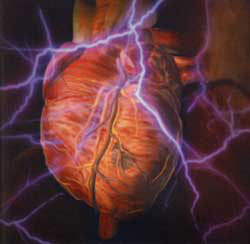Every person can sense that his heart rate increases when he quickly climbs up a multiple flight of stairs, runs or gets excited, and then after exertion, the heart rate returns to its previous pace. However, it is generally not recognized how great a miracle this actually is. The rate of the heartbeat is organized by a perfect structure that resembles a computer system placed inside the body.
When the heart rate increases, if not enough oxygen is supplied to the body, then the cells lose their electrical balances, and begin to beat irregularly and in a speedy way. Therefore, it is very important that the heart beats at a settled rhythm continuously. We may compare this to a car traveling at a steady speed. However, under certain conditions, the heart rate needs to be increased or decreased. This resembles a car traveling at a steady speed either being accelerated by stepping on the gas, or being slowed down by stepping on the brake. The brake pedal that decreases the heart rate is the vagus nerve and the gas pedal that increases the heart rate is the sympathetic nervous system. What makes the “brake pedal” (the vagus nerve) go into action is the messenger molecule called acetylcholine. The heart that beats 72 times per minute under normal circumstances increases its SA node (the group of cells that adjust the heartbeat rate) speed when one overexerts, is under stress, when one gets a temperature or other such extraordinary conditions, because more blood is required. In this way, the blood required is pumped. The sympathetic nervous system narrows the veins and increases blood pressure; moreover the suprarenal gland secretes adrenalin and noradrenalin hormones. These hormones increase the working rate of the heart. The thyroxine hormone secreted by the thyroid gland accelerates the metabolism and effects the heart’s functioning. The increased heart rate can now increase the heart’s efficiency five times more than at resting level.
The heart that beats 72 times per minute under normal circumstances increases its SA node (the group of cells that adjust the heartbeat rate) speed when one overexerts, is under stress, when one gets a temperature or other such extraordinary conditions, because more blood is required. In this way, the blood required is pumped. The sympathetic nervous system narrows the veins and increases blood pressure; moreover the suprarenal gland secretes adrenalin and noradrenalin hormones. These hormones increase the working rate of the heart. The thyroxine hormone secreted by the thyroid gland accelerates the metabolism and effects the heart’s functioning. The increased heart rate can now increase the heart’s efficiency five times more than at resting level.
The sympathetic nervous system accelerates the heart, much like a gas pedal in a car; to slow it down is the task of the parasympathetic system. The parasympathetic system can moderate the contraction strength of the heart muscles when needed, and slow the heart rate down to 40 beats per minute. When the receivers in the arteries sense the blood pressure increasing, they warn the brain via parasympathetic nerves to secrete the chemical called acetylcholine. Thus the blood veins expand; pressure falls. If the veins that carry blood did not enlarge, they would tear and break up. As a result, the skull may be filled with blood, and the person could become paralyzed as not enough blood reaches the brain.
This order, which requires many conditions to come together in perfect flawlessness, is one of the examples that introduce our Almighty Lord’s knowledge. In one verse of the Qur’an it is revealed as follows:
“...My Lord encompasses all things in His knowledge so will you not pay heed?” (Surat al-An‘am, 80)


